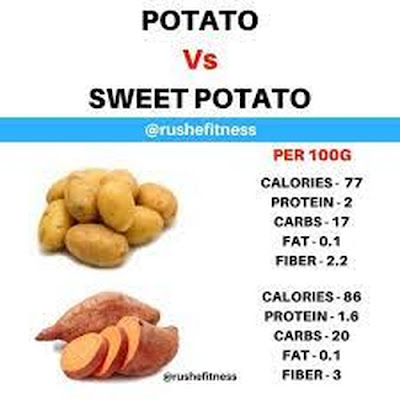Potatoes have less than one percent fiber. While truth about sweet potato nutrition is that they have a high fiber content and only ten to twenty times the fiber of rice or flour. Sweet potatoes are rich in potassium and are the only true low-calorie vegetables. In addition to its low calorie content, purple sweet potatoes are a good source of potassium and magnesium, vitamins A, C, E and K.
According to sweet potato nutrition facts, it is recommended to eat at least six small to medium-sized baked sweet potatoes daily. In addition to having a low-calorie, heart healthy food, it is also good for you health. It contains plenty of vitamins, minerals, dietary fibers, proteins and complex carbohydrates. It is also a good source of vitamins A, D, E and K, fatty acids, phosphorus, potassium and magnesium.
As sweet potatoes contain potassium, they help in regulating blood pressure, insulin levels and cholesterol levels. They increase your energy level as it helps in rapid metabolic processes. They also improve the digestion process. Moreover, they decrease the risk of heart diseases and cancers. Sweet potatoes contain flavonoids and polyphenols, which are antioxidants, are important for human health as it prevents cancer and helps in cell growth.
One of the major nutrition facts about sweet potatoes is that it has high-glycemic index. Due to its high-glycemic index, it causes a rapid spike in blood glucose level, thereby increasing the risk of diabetes. Therefore, diabetic patients should avoid sweet potato. As for non-diabetic individuals, it has a low glycemic index. However, due to certain pesticides used for growing them, some research reveals that some trace amounts of glycemic index may still exist in these fruits.
According to sweet potato nutrition facts, studies have shown that this vegetable has a lot of antioxidants. Antioxidants prevent DNA damage and free radical formation. They also play an important role in the maintenance of cellular membranes and DNA repair. Based on several studies, baked sweet potatoes have more antioxidants than any other vegetable.
Moreover, sweet potato is considered a very good source of vitamin A, vitamin B-complex and vitamin C. Based on studies, almost 90 percent of the sweet potato contains vitamin A. This vitamin is essential for healthy eyes and vision. The vitamin B-complex and vitamin C are also considered as excellent sources of nutrients that maintain eye health. However, these vitamins must be consumed in moderate to large doses to achieve the maximum benefit. Sweet potato is also a good source of iron.
These days, sweet potatoes offer so many health benefits to us. It is not only delicious but also helps in maintaining a healthy body weight. It is high in fiber, minerals and vitamins which are very helpful in maintaining a healthy skin and hair. So, if you want to enjoy these health benefits to the fullest then add baked sweet potatoes to your diet. You will surely love its wonderful flavor and health benefits.
When compared with white rice, sweet potatoes offer almost the same amount of dietary fiber per serving. However, it is much healthier than white rice. Studies have revealed that consuming sweet potatoes offer more iron than any other vegetables. As a matter of fact, sweet potato has three times the amount of iron found in whole grains. Therefore, this vegetable can provide you with all the mineral and dietary fiber you need daily.
Although sweet potatoes have antioxidant content, it does not contain significant amounts of Vitamin C and iron. In fact, studies have revealed that dietary fiber from sweet potatoes helps in reducing the risk of developing cancer. So, if you want to reduce the risk of developing cancer and heart disease, then include this vegetable in your diet on a regular basis. According to the research, the purple-fleshed sweet potatoes are rich in antioxidant content and also contain a high level of dietary fiber. Therefore, this vegetable offers great nutritional benefits to your daily meals.
Also, sweet potatoes may help in improving eyesight. Recent studies have revealed that the potassium found in sweet potatoes may help in improving eyesight. Specifically, the potassium may help in improving nighttime vision and visual clarity as well as in reducing the risk of age-related eye problems such as vision loss and eye fatigue. In addition, the potassium also helps in improving night vision and improving visual clarity. Therefore, if you want to improve your vision, then consider including this vegetable in your diet on a regular basis.
